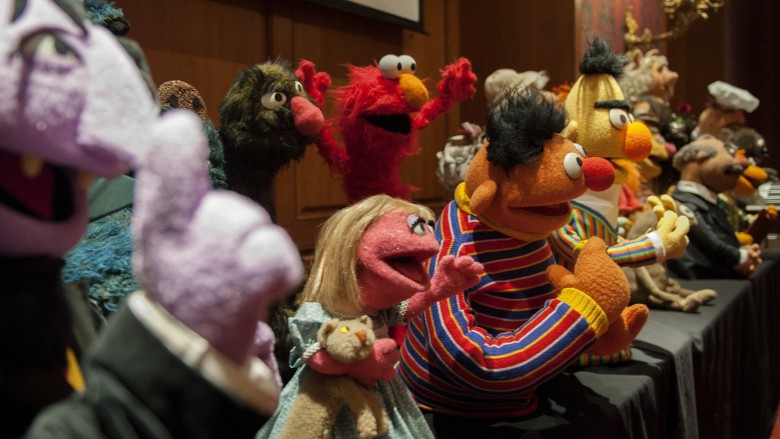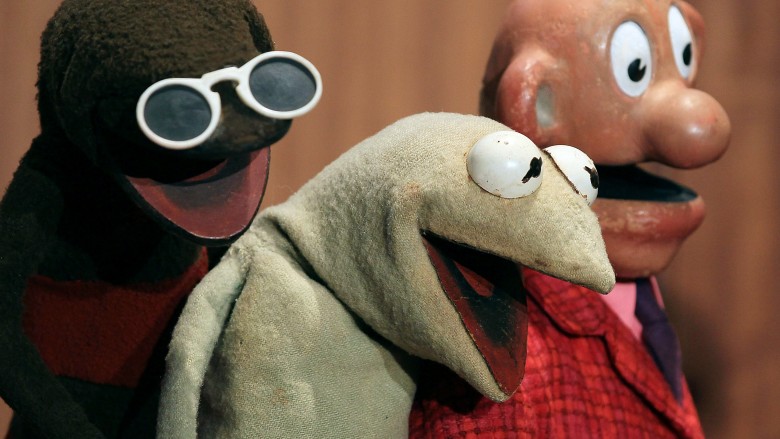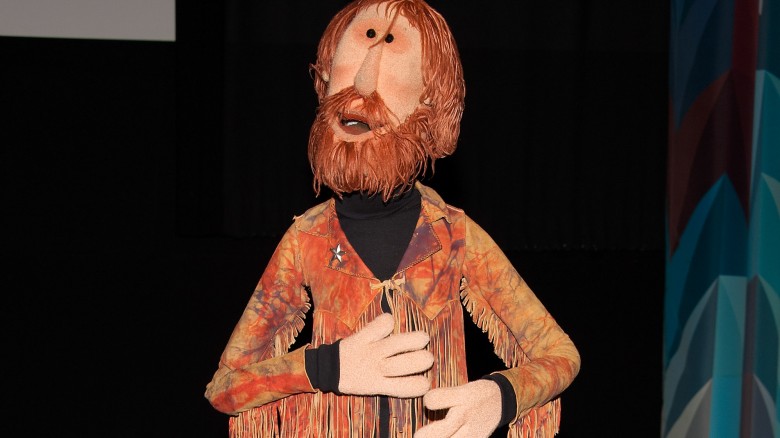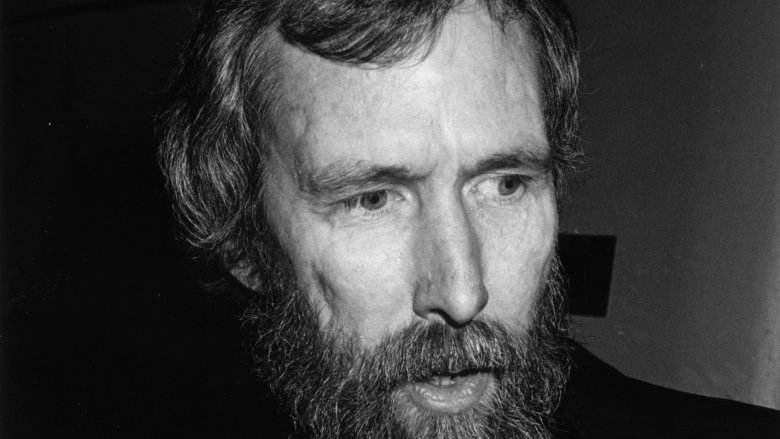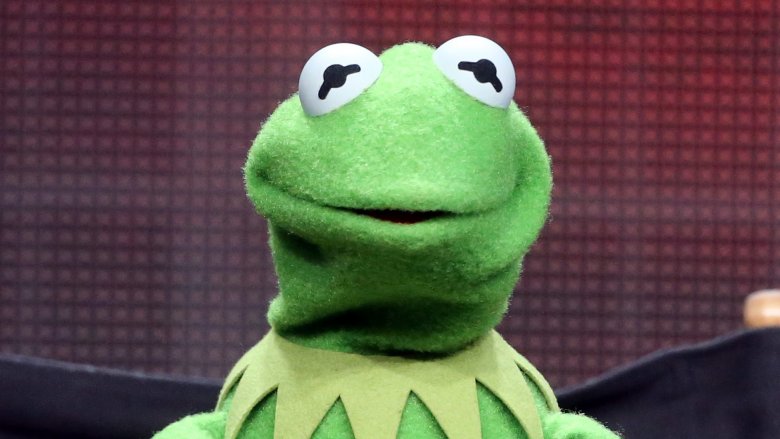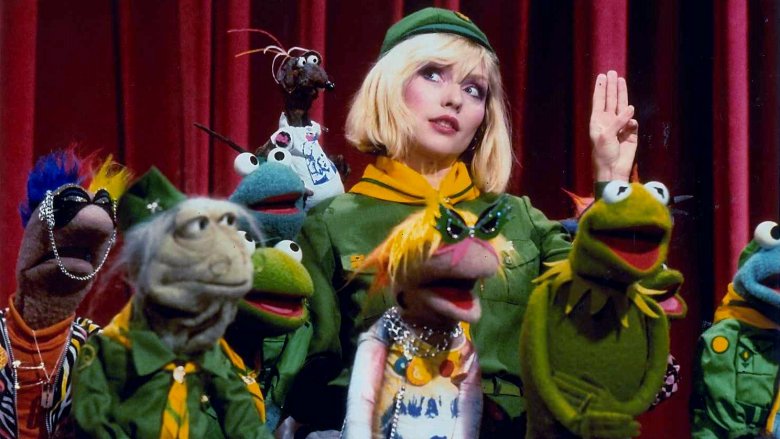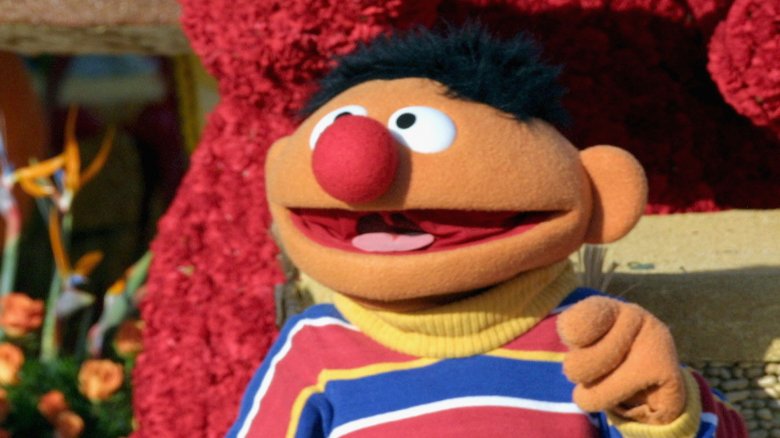The Untold Truth Of Jim Henson
Before Jim Henson, puppeteering was mostly the realm of vaudeville frivolity and avant-garde weirdness. Jim Henson made puppets (Muppets) that you'd want to talk to and hug instead of the dead-eyed horror automatons prevalent in other television shows of the '50s and early '60s. Here's a list of things you might not know about him.
Henson wasn't even sure he wanted to be a puppeteer
Innovative and groundbreaking puppeteer work dominated Jim Henson's entire life, so much so that you'd think it was the culmination of a lifelong dream or something. In reality, it was more of a means to an end, with a whipped cream sundae topping of "Screw you, dad."
At 17, Henson wasn't sure what he wanted to do with his life, but like every 17-year-old alive in the past 70 years or so, he wanted to get on television somehow. It just so happened that the local television station WTOP was looking for puppeteers, so Henson and his buddy quickly whipped up a few puppets and a routine for an audition. They were hired, but the show, while popular and well received, was canceled after a few episodes.
Swooping in like a villain in an '80s movie, Henson's father then sent him to college to discourage him from his frivolous television pursuits and take a more serious role in academics or engineering. Presumably while donning a pair of cool sunglasses, Henson instead devoted his time in college even more toward artistic pursuits, doing puppetry at a nearby television station and building the chops that made him a household name a decade or so later.
Kermit the Frog had humble beginnings
Kermit the Frog has become such an iconic character in the decades he's been on the air that we bet you will involuntarily read the rest of this passage in his voice just because we told you to. His cultural longevity is much more surprising when you realize he was created with the sort of slapdash cobbling of garbage one might throw together for a school project the night before it's due.
Henson's first major break was a show called Sam and Friends, and Kermit debuted there. Kermit wasn't even definitively a frog yet but some sort of vague lizard thing. Still a teenager at the time and pretty much just working with whatever he could get his hands on, Henson crafted Kermit out of scraps from a coat his mother was throwing away and a ping-pong ball cut in half for eyes. So keep in mind how many potential multi-million-dollar industries you chuck out every time you take out the garbage rather than crafting that trash into cultural icons.
Even Jim Henson's beard has a backstory
Though the majority of his career had him hidden behind things with his hands jammed up Muppet keister, Jim Henson had a recognizable look. Part of that look was his trademark beard. Given his age and the era in which he became famous, you'd assume it may have been a hippie or beatnik thing. You'd be completely wrong and should just let us tell you instead of wasting our time with assumptions.
After a few years of his show Sam and Friends being on the air, Henson needed a break. He brought on some folks to fulfill his duties on the show and took a trip to Europe, seeking out various puppet shows across the countryside whose craftsmanship and performance inspired him and reinvigorated his belief in his own craft as an art form.
He came back ready to reinvent his work and had started by reinventing his image. From his return onward, he sported a very European-style beard that, according to him, masked the acne scars of his youth. While most folks these days sprout a beard to announce how they've given up, Henson had only just begun.
His commercial work was frequently insane
In some ways, Jim Henson's commercial work is more bizarre than the stuff he did on his own. For instance, there was the dozens of commercials where shapeless puppets murder each other over coffee (even in color!). But there's a difference between depicting puppet violence and endangering his own life, which brings us to his commercials for Southern Bread.
For one commercial, he had an archer shoot an arrow off the puppet's head. This could easily have been achieved with a broomstick or something holding the puppet up, but Henson insisted on being right there with all his vital squishy organs give or take a foot away from a real arrow being shot his direction. And that's not the craziest part! No, the craziest part is Henson insisting on five takes because he was unsatisfied how the first four turned out.
Another commercial had him lying on a train track in front of an oncoming train, without notifying the train company. The train whistle going off is real, by an engineer having to deal with two random idiots and a puppet lying in the middle of the tracks with a camera crew filming them. In all likelihood, the train engineer spent the rest of his life wondering what sort of kinky weirdness was happening on the tracks that day.
Jim Henson was only nominated for one Oscar his whole life, and it wasn't for puppetry
Despite all the groundbreaking work he did in film over the years, Jim Henson was only once himself nominated for an Oscar. Strangely enough, the award wasn't for any of his work involving The Muppets, or any of his puppetry work at all. Instead, it was for an obscure artistic short film he created called Time Piece.
Running less than 10 minutes long, it's a surrealistic montage combining everyday vignettes and strange fantasy sequences with an overarching theme of the passage of time. It used unsettling stop motion techniques that would later be used in Sesame Street to create terrifying sketches about fruit singing opera.
Henson's more modern work embraced literal NASA technology
The vast majority of the hundreds of puppets Henson designed in his life were fairly traditional. However, when he branched out into film, he needed designs that could be shot from multiple angles, which would be difficult while shuffling around an operator with his hand up the Muppet's patoot.
Animatronic technology existed, but it was bulky and required lots of cable work. That wasn't going to work for the smaller or more mobile puppets Henson was picturing. However, Henson's design lead Don Sahlin and engineer Faz Fazakas had a new trick up their sleeve: radio-controlled puppetry.
Working off of designs originally developed by NASA engineers, they created radio controlled-devices that could control a puppet's mouth via a device that looked like an electronic mitten. Other puppets were made that could pilot vehicles such as boats, to the delight of Henson almost more than the viewers. These techniques were honed and combined with animatronic and other sorts of remote workings into "super puppets" in later films like Dark Crystal and Labyrinth.
By the time the Jim Henson Workshop was working on the first Teenage Mutant Ninja Turtle film (one of the last Henson would work on before he died), they had specialized puppet suits with all the controls for facial expressions hidden in the turtle shell, giving the actor full control of the rest of the suit. By the end, Donatello the teenage mutant puppet turtle had more dramatic acting range in his robot face than his voice actor Corey Feldman.
Jim Henson's first major project was almost an adaptation of the Wizard of Id comic strip
Before Sesame Street, before The Muppet Show, Jim Henson was looking to branch out from the locally broadcast Sam and Friends into something nationally syndicated. Hard to believe, but it was almost an adaptation of a medieval-themed comic strip. Henson was a fan of the Sunday funnies and wanted to create a show based on Johnny Hart's comic strip Wizard of Id.
A pilot was created for ABC and was well received, but the network was slow to sign a contract for it. Growing impatient, Henson went ahead and created the iconic Sesame Street instead, because "going ahead and creating the iconic Sesame Street" was the sort of thing you could do when you are Jim Henson.
Henson practically tortured himself in the opening shot of the first Muppet Movie
The first few moments of The Muppet Movie are still pretty incredible to watch. The camera pans in from an overhead view into a swamp, settling on Kermit, sitting on a log playing a banjo. The camera moves closes in from several angles, yet Kermit still looks as natural as a felt puppet is capable of looking. How did they do that?
Well, hopefully it doesn't take too much magic away from the scene knowing that the whole time, Henson is sweating in a makeshift diving bell under the water in that fake swamp. The original diving bell designed to his measurements was five feet in diameter, but the water in the fake swamp was four feet deep. Henson, who we should remind everyone stood over six feet tall, went ahead and had them shave a whole other foot of exterior space off, forcing him to contort into a nearly impossible pretzel shape to get in. It took five days to shoot the sequence, and after one particularly rough shoot, it took effort to get his legs working right again after sitting in that cramped space for three hours.
But hey, that song is really pretty.
Jim Henson almost signed the Muppets over to Disney before he died
Hard to believe, but Jim Henson was considering selling Henson Associates (now known as The Jim Henson Company) to Disney for $200 million. That's especially hard to believe considering at the time, The Jim Henson Company was really starting to make a name for themselves in special effects. Not to mention the continued success of Sesame Street and other Muppet-based properties. He was at the top of his game, and we may never know exactly why he wanted to cash out. But he did.
Unfortunately, or of indeterminate fortune depending on your opinion of the subject, Henson's death ended negotiations on that deal. As Henson's estate took over the company to continued but occasionally sporadic success (Muppets From Space, anyone? No? Understandable) Disney came knocking again. In 2003, Disney struck a deal and acquired The Muppets (but none of the Sesame Street characters or lesser-known Jim Henson's Creature Chop properties).
It got us that Muppet movie with Jason Segel that makes us cry. C'mon you can admit it. You cry too.
Nobody wore black at Jim Henson's funeral
Henson's funeral service, a few days after his death in May 1990, was a surprisingly lighthearted experience considering the circumstance. He had requested previously that nobody should wear black and that a jazz band play "When The Saints Come Marching In." So far so good.
Longtime creative partner Frank Oz discussed a time Jim Henson took naked photos of him, and it's a really wholesome story. Puppeteer Richard Hunt gave a moving eulogy that became even more poignant in hindsight considering he died of AIDS-related complications two years later and was memorialized in that same cathedral.
Caroll Spinney, as Big Bird, sang a rendition of "It's Not Easy Being Green" that will rip your goldang heart out. Harry Belafonte reprised his performance and introductory preface of his song "Turn The World Around" that he had debuted on The Muppet Show a decade or so before.
The service ended with a medley of Henson's favorite tunes, as audience members participated with their own personal butterfly puppets. It's all very sweet and joyful and sometimes sad and we ... have to ... go somewhere now. There's just ... so much dust in here. Eyes are watering for some reason.
His death came from out of nowhere
Today, most bacterial infections and respiratory diseases are treatable (if not curable) with vaccines and antibiotics, but they're deadly if not taken care of fast enough. In many cases, the drugs don't work if they're administered too late, after the microbes have spread around the body. The New York Times reported in May 1990 that pneumonia was still the sixth-leading cause of death in the United States. That's when it killed Jim Henson, just 53 years old, over a shockingly short period of infection.
More specifically, according to Dr. David Gelmont, who led the unit that treated Henson at New York Hospital, the Muppet maker died from toxic shock syndrome caused by pneumonial bacteria. It's a nasty bug, but one that can be knocked out. Had Henson arrived at the hospital only a few hours earlier, Dr. Gelmont thinks his life could have been saved. During the previous weekend, Henson thought he was fighting a cold; according to Entertainment Weekly, his daughter, Cheryl, seemed worried, but Henson said he was "just tired." He felt worse and worse, canceling a recording session scheduled for Monday, May 14, and later that day he was coughing up blood. That night, as he finally agreed to seek treatment at New York Hospital, his organs began to shut down. He suffered two heart attacks before passing away on the morning of May 16, 1990.
So many unmade Muppet projects
Jim Henson was obviously a creative guy. He generated scores of ideas for Muppet projects, but there's only so much time in a day, or in a lifetime. When Henson died in 1990, he left behind a number of unrealized projects in various states of creative limbo.
When Henson died, Disney was in the process of acquiring the Muppets, and the two entities had already begun work on a few projects. According to Muppet historians, Henson's team shot two episodes of Little Mermaid's Island, a puppet-based Disney Channel spinoff of Disney's animated The Little Mermaid. In the mid- to late 1980s, Henson and cohorts Jerry Juhl and Frank Oz began work on (but didn't finish) The Cheapest Muppet Movie Ever Made, an intentionally terrible and wacky B-movie on the conceit that it's directed by Gonzo. Two other Muppet movies that Henson never made: One where the Muppets go on an archaeological expedition to discover their origins, and one about Miss Piggy getting pregnant.
They could make a show about how hard it was to get The Muppet Show made
The Muppet Show debuting in 1976. It was the beginning of five seasons of classic television, and it was the end of Jim Henson's seven-year struggle to get the thing on air. After years as a fixture on the TV variety show circuit, Henson figured it was time he and his posse had its own weekly televised showcase. According to Brian Jay Jones' Jim Henson: The Biography, in the summer of 1969, Henson wrote a proposal for The Muppet Show, a concept for a half-hour primetime big-budget show starring the Muppets." Even then he had it all figured out, promising a show both adults and kids could enjoy and which would feature "a loose assemblage of bits and pieces, incorporating a guest star each week" to perform in sketches and musical numbers alongside various Muppets.
He tweaked the proposal some more, and in 1973, ABC agreed to produce a pilot. It aired in January 1974 as a special, The Muppets Valentine Show. ABC executives liked it ... although network president Martin Starger wasn't yet ready to commit to a series, only a few more holiday specials. One of those was the jokingly titled The Muppet Show: Sex and Violence in 1975. It got decent reviews, but ABC told Henson there would be no permanent Muppet Show on its airwaves. A few months later, CBS turned down the project, too.
The man who realized The Muppet Show would work was English TV mogul Lew Grade. He signed Henson to produce the show in the U.K., and then agreed to syndicate it to American TV stations.
He was a pop sensation
Jim Henson was a consummate entertainer. Not only did he create countless Muppets and imbue them with personality, but he controlled them and provided their voices, a specific and difficult performance that's both acting and being part of the film crew at the same time. He also directed television and film, ran a company, and during the Muppets' peak of popularity and influence in the 1970s he found the time to score a couple of top 40 hit singles.
How'd he do it? Semi-secretly, in character as two of his creations. Yes, the '70s were wild, wild enough that songs for children credited to puppets could move 45s at the record store. In September 1970, "Rubber Duckie," that standard about bath-time fun from Sesame Street, peaked at No. 16 on the Billboard Hot 100. It was credited to "Ernie (Jim Henson)." Nine years later, Henson hit the charts again. "Rainbow Connection," the beautiful and powerful song that opened The Muppet Movie reached No. 25 on the hit parade. The artist: "Kermit (Jim Henson)."

